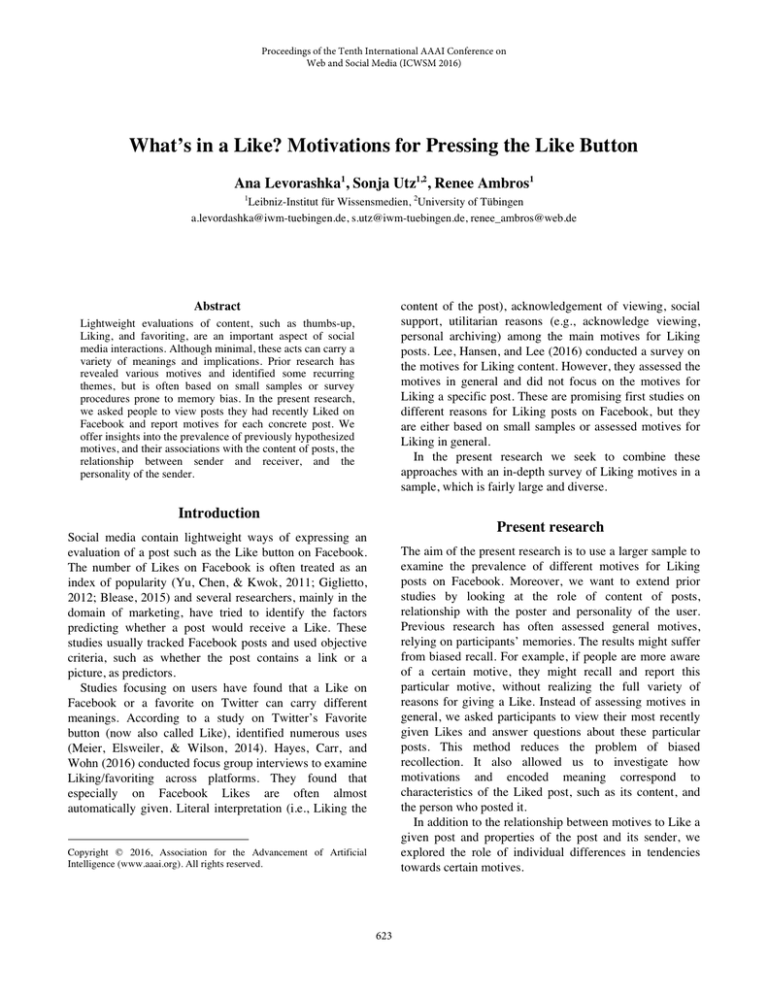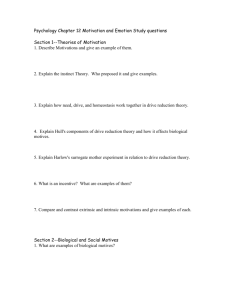
Proceedings of the Tenth International AAAI Conference on
Web and Social Media (ICWSM 2016)
What’s in a Like? Motivations for Pressing the Like Button
Ana Levorashka1, Sonja Utz1,2, Renee Ambros1
1
Leibniz-Institut für Wissensmedien, 2University of Tübingen
a.levordashka@iwm-tuebingen.de, s.utz@iwm-tuebingen.de, renee_ambros@web.de
content of the post), acknowledgement of viewing, social
support, utilitarian reasons (e.g., acknowledge viewing,
personal archiving) among the main motives for Liking
posts. Lee, Hansen, and Lee (2016) conducted a survey on
the motives for Liking content. However, they assessed the
motives in general and did not focus on the motives for
Liking a specific post. These are promising first studies on
different reasons for Liking posts on Facebook, but they
are either based on small samples or assessed motives for
Liking in general.
In the present research we seek to combine these
approaches with an in-depth survey of Liking motives in a
sample, which is fairly large and diverse.
Abstract
Lightweight evaluations of content, such as thumbs-up,
Liking, and favoriting, are an important aspect of social
media interactions. Although minimal, these acts can carry a
variety of meanings and implications. Prior research has
revealed various motives and identified some recurring
themes, but is often based on small samples or survey
procedures prone to memory bias. In the present research,
we asked people to view posts they had recently Liked on
Facebook and report motives for each concrete post. We
offer insights into the prevalence of previously hypothesized
motives, and their associations with the content of posts, the
relationship between sender and receiver, and the
personality of the sender.
Introduction
Present research
Social media contain lightweight ways of expressing an
evaluation of a post such as the Like button on Facebook.
The number of Likes on Facebook is often treated as an
index of popularity (Yu, Chen, & Kwok, 2011; Giglietto,
2012; Blease, 2015) and several researchers, mainly in the
domain of marketing, have tried to identify the factors
predicting whether a post would receive a Like. These
studies usually tracked Facebook posts and used objective
criteria, such as whether the post contains a link or a
picture, as predictors.
Studies focusing on users have found that a Like on
Facebook or a favorite on Twitter can carry different
meanings. According to a study on Twitter’s Favorite
button (now also called Like), identified numerous uses
(Meier, Elsweiler, & Wilson, 2014). Hayes, Carr, and
Wohn (2016) conducted focus group interviews to examine
Liking/favoriting across platforms. They found that
especially on Facebook Likes are often almost
automatically given. Literal interpretation (i.e., Liking the
The aim of the present research is to use a larger sample to
examine the prevalence of different motives for Liking
posts on Facebook. Moreover, we want to extend prior
studies by looking at the role of content of posts,
relationship with the poster and personality of the user.
Previous research has often assessed general motives,
relying on participants’ memories. The results might suffer
from biased recall. For example, if people are more aware
of a certain motive, they might recall and report this
particular motive, without realizing the full variety of
reasons for giving a Like. Instead of assessing motives in
general, we asked participants to view their most recently
given Likes and answer questions about these particular
posts. This method reduces the problem of biased
recollection. It also allowed us to investigate how
motivations and encoded meaning correspond to
characteristics of the Liked post, such as its content, and
the person who posted it.
In addition to the relationship between motives to Like a
given post and properties of the post and its sender, we
explored the role of individual differences in tendencies
towards certain motives.
Copyright © 2016, Association for the Advancement of Artificial
Intelligence (www.aaai.org). All rights reserved.
623
3-factor solution. The 3 factors, labelled literal
interpretation, relational motives, and social motives,
explained 48% of the variance (Table 1). Bartlett factor
scores were calculated and used as dependent variables.
Method
Participants and procedure
The survey was conducted online. We had a convenience
sample with participants recruited from a UK-based online
participant pool and a mailing list of German university.
The questionnaire was completed by 341 participants, 310
of which passed the primary attention check (52% female).
The majority of participants were from the UK (32%)
followed by Germany (18%) and the USA (17%).
Participants were instructed to open Facebook, view and
briefly describe each of their 8 most recently Liked posts.
A set of questions was repeated for each of the 8 likes.
Personality, demographics, and media use were measured.
Measures
Motivation
Motivation for Liking a post was assessed with six items
(Table 1) on a scale from 1 to 100. Two additional items
assessed whether Liking the post was deliberate (pressed
almost automatically and thought carefully) and whether
the participant felt obliged to Like the post.
Content and poster
Participants indicated whether a post was an original status
update and whether it contained text, a photo, or a video.
To describe the content of posts, participants could select
all applicable categories from a list of categories (e.g.,
hobbies, career). Each post was evaluated on the
dimensions of negative–positive, non-intimate–intimate),
boring–entertaining. Participants were asked about the
person who posted the update (poster): the poster’s gender;
how close participants are to the poster; how often they
Like posts by this person, and vice versa.
Personality
We measured self-esteem, self-monitoring, and need to
belong. All items were measured on a scale from 1
(strongly disagree) to 7 (strongly agree).
Analysis
Likes were nested within participants. We therefore
analyzed the data using linear mixed-effects models (lme,
from R package "lme4"; Bates, Maechler, Bolker, &
Walker, 2014) with random intercepts for participant and
all factors of interest considered as fixed effects.
Items
Wording
Descr.
Factors
M (SD) REL LIT
SOC
Liked this post because of its
content (e.g. find the post funny,
interesting, relatable, etc.)
Liked this post mainly because
of the person who posted it
Liked this post in order to
maintain or strengthen
relationship with the poster
Liked this post to show support
(e.g., congratulations, good
wishes, condolences)
Liked this post mainly because
many other people Liked it.
Liked this post mainly in order
to signal/acknowledge that you
have seen or read the post.
78 (27)
1
49 (36) 0.46
.21
40 (34) 0.91
52 (39)
0.4
16 (25)
0.56
42 (37)
0.52
Range
Eigen value
Variance explained
-1.7:2.1 -3:0.9 -2.3:4.2
2.28
1.03
0.88
.11
.17
.25
Notes. REL: Relational; LIT: Literal, SOC: Social.
Coefficients < .2 are suppressed.
Table 1. Summary of raw motives items and factor scores.
Deliberateness and obligation
The deliberateness of action was not associated with any of
the motives. Feeling of obligation was positively related to
relational ( = .1, p < .001) and social motives ( = .18, p <
.001) and negatively to literal motives ( = -.15, p < .001).
Content type
The most common categories were posts related to hobbies
and interests, entertainment, current experiences, and
social and major life events.
Results
Motives
Averaged across all Liked content (n = 2479), literal
interpretation was the highest-rated motive. Descriptives
can be seen in Table 1. An exploratory factor analysis
(maximum-likelihood with oblimin rotation) and chose a
Figure 1. Frequencies of reported content categories.
624
Relationships between motives and content type can be
seen in Figure 3. Entertaining posts were Liked because of
content (literal interpretation) rather than social reasons.
Literal interpretation was also dominating over social
motives for moral/political posts, but for such posts people
tended to think more deliberately. Life events were Liked
for social reasons and because people felt obliged to do so.
of obligation (Table 2a). Entertaining posts were Liked
primarily for their content (literal interpretation) and less
due to social motives and feelings of obligation. Similarly,
the positivity of posts was positively related to relational
and literal motives. Positive posts were more likely to be
Liked automatically, without careful consideration.
Relationship with poster
Results can be seen in Table 2b. The closer participants felt
to another user, the more they Liked his/her post out of
relational motives, such as desire to maintain the
relationship, and less because of the content or social
reasons. However, they also perceived Liking these posts
as more obligatory. Liking the posts of people who
frequently Liked participants’ own posts on the other hand
was associated with social motives, which likely reflects a
form of reciprocity.
Personality
Perhaps not surprisingly, need to belong was associated
with Liking for the sake of relational maintenance (Table
2c). Individuals with high need to belong seek to maintain
and continuously reaffirm their relationships. Our findings
suggest that they adopt Liking as a relationship
maintenance strategy. Self-monitoring is a trait linked to
greater adherence to norms and strategic social behavior.
Indeed, participants high on self-monitoring Liked content
for social purposes, such as acknowledging viewing and
adhering to norms. Interestingly, they did not report higher
levels of deliberation. Self-esteem was neither related to
the motives for Liking content nor the way of Liking posts.
Figure 2. Motives as a function of content
Content valence
Posts evaluated as intimate were Liked due to relational
and social motives and positively associated with feelings
Dependent variable
Relational
Literal
Social
Deliberateness
Felt obliged
a. Content
Superficial–Intimate
Boring–Entertaining
Negative–Positive
Log Likelihood
0.13 (0.02)***
-0.02 (0.02)
0.29 (0.02)***
-0.03 (0.02)
***
0.07 (0.02)
-3,192.26
0.08 (0.02)
***
-3,209.41
0.14 (0.02)***
-0.01 (0.02)
-0.07 (0.02)***
0.01 (0.02)
*
0.04 (0.02)
-0.14 (0.02)
0.13 (0.02)***
-0.13 (0.02)***
***
-2,833.45
-2,938.31
0.04 (0.02)
-0.02 (0.02)
0.04 (0.02)*
-2,991.59
b. Relationship to poster
Closeness to poster
Habit
0.22 (0.02)***
0.12 (0.03)
***
-0.10 (0.03)***
**
0.11 (0.03)
0.02 (0.03)
Reciprocity
0.06 (0.03)
-0.003 (0.04)
0.10 (0.03)
Log Likelihood
-3,033.00
-3,338.08
-2,843.76
0.04 (0.04)
0.04 (0.05)
0.10 (0.02)***
*
-0.07 (0.03)
***
0.01 (0.03)
-0.05 (0.03)
0.06 (0.03)
-2,949.19
-3,013.82
-0.03 (0.05)
-0.02 (0.04)
c. Personality
Factor: Need to belong
0.11 (0.04)**
*
*
Factor: Self-esteem
0.08 (0.04)
-0.01 (0.04)
0.11 (0.05)
0.08 (0.05)
0.06 (0.05)
Factor: Self-monitoring
0.09 (0.04)
-0.10* (0.04)
0.21 (0.05)***
0.04 (0.05)
0.22 (0.05)***
Log Likelihood
-3,213.66
-3,342.75
-2,871.42
-2,969.22
*
Observations in each model: 2,479
Table 2. Summaries of multilevel models.
625
-3,035.65
**
p<0.05; p<0.01; ***p<0.001
important to consider interactions between the variables we
explored, as well as additional factors, such as the
sentiment of posts and the way different uses of the Like
button contribute to relational maintenance. Some of these
questions can already be informed by the data we have
collected, whereas others would require further research.
Another notable research direction comes from the
recent introduction of Facebook reactions (Facebook,
2016). The reactions now offered by Facebook represent
different emotions and do not map onto the uses we and
others have identified, but it will be interesting to compare
which reactions are used for which motives.
Discussion
This research contributes to the understanding of the
motivations behind pressing Facebook’s Like button.
Together with addressing some limitations of prior
research, the present design allowed for detailed,
systematic account of how different motives relate to the
content of posts, the relationship between a poster and a
Liker, as well as the personality of the Liker.
We find evidence for different motives to Like content
on Facebook. Interestingly, Liking the content of the post,
i.e., literal meaning of a Like, was the most common
motive. This is the original meaning intended by Facebook,
but it has often been claimed that people use the Like
button in many different ways. Our further results are
consistent with this idea, revealing that people Like posts
in order to show support, as a reaction to the person who
shared the content, to maintain their relationships,
acknowledge seeing content, and, to a lesser extent,
because of social norms (other people Liking the post).
Three distinct factors emerged from these separate
motives, distinguishing content-based Liking (literal
interpretation) from relational motives and social
functions, such as acknowledgment and expressing
support. These factors are consistent with theoretical
speculation and insights from qualitative research with
limited samples. Our work offers empirical support for
these previously proposed motives from a diverse sample
of users. A major advantage is that participants reported
their motives for specific content they had previously
Liked, which makes their answers less prone to recall
biases, such as availability of information and lay theories
of behavior. The design allowed us to explore the role of
what was Liked (content), the relationship with the poster
and the personality of the Liker. We found meaningful
relationships between the different motives to Like a post
and the post’s content type and valence. We also found that
the relationship with the poster and the personality of the
Liker also mattered.
Before closing, we would like to note some limitations
of the research. We used convenience sample, which limits
the generalizability of our findings and prevents us from
drawing valid conclusions about demographic differences.
The contribution of our work thus lies rather in showing
that in a large, diverse sample, and with a method that
reduces the problem of biased recall, we identify themes in
people’s motives to use the Like button, similar to what
has been proposed by qualitative research done with very
small samples. Together with this prior research, we build
towards better categorization and measurement of the
different uses of the Like button, which can then be
adopted in research employing representative samples.
In this paper, we consider and report only first
exploratory analyses, without going in depth. It would be
References
Barash, V., Duchenaut, N., Isaacs, E., &
Faceplant: Impression (Mis) management
updates. In Proceedings of the Fourth
Conference on Weblogs and Social Media
Alto, CA.
Bellotti, V. (2010).
in facebook status
International AAAI
(pp. 207–210). Palo
Bates D. M., Mächler M., Bolker B. M., Walker S. C. (2014).
lme4: Linear Mixed-Effects Models Using Eigen and S4. R
Package Version 1.1-7. Available online at: http://CRAN.Rproject.org/package=lme4
Blease, C. R. (2015). Too many “friends,” too few “likes”?
Evolutionary psychology and “Facebook depression”. Review of
General Psychology, 19(1), 1–13. doi:10.1037/gpr0000030
Facebook (2016). Reactions Now Available Globally.
http://newsroom.fb.com/news/2016/02/reactions-now-availableglobally/
Giglietto, F. (2012). If Likes Were Votes: An Empirical Study on
the 2011 Italian Administrative Elections. In ICWSM.
Hayes, R. A., Carr, C. T., & Wohn, D. (2016). One click, many
meanings: Interpreting paralinguistic digital affordances in social
media. Journal of Broadcasting & Electronic Media.
doi:10.1080/08838151.2015.1127248
Lee, S.-Y., Hansen, S. S., & Lee, J. K. (2016). What makes us
click “like” on Facebook? Examining psychological,
technological, and motivational factors on virtual endorsement.
Computer
Communications,
73(Part
B),
332–341.
doi:10.1016/j.comcom.2015.08.002
Meier, F., Elsweiler, D., & Wilson, M. L. (2014). More than
Liking and Bookmarking? Towards Understanding Twitter
Favouriting Behaviour, 346–355.
Utz, S. (2015). The function of self-disclosure on social network
sites: Not only intimate, but also positive and entertaining selfdisclosures increase the feeling of connection. Computers in
Human Behavior, 45, 1–10. doi:10.1016/j.chb.2014.11.076
Yu, B., Chen, M., & Kwok, L. (2011). Toward predicting
popularity of social marketing messages. Social Computing,
Behavioral-Cultural Modeling and Prediction, Lecture No, 317–
324.
626




